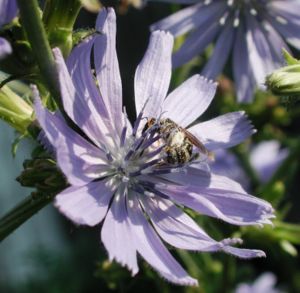Chicory: Difference between revisions
Jump to navigation
Jump to search

imported>David L Green (more data) |
mNo edit summary |
||
| Line 4: | Line 4: | ||
The leaves have a bitter taste, and are used as [[salad greens]]. The roots can be eaten boiled, or can be roasted and ground to produce a flavoring for [[coffee]]. Some roots are also used for [[livestock]] feed. As a wildflower, it is also known as "ragged blue sailor." It has a preference for well drained, gravelly soil, and is a common roadside wildflower from Tennessee northward throughout eastern USA blooming from July until frost. | The leaves have a bitter taste, and are used as [[salad greens]]. The roots can be eaten boiled, or can be roasted and ground to produce a flavoring for [[coffee]]. Some roots are also used for [[livestock]] feed. As a wildflower, it is also known as "ragged blue sailor." It has a preference for well drained, gravelly soil, and is a common roadside wildflower from Tennessee northward throughout eastern USA blooming from July until frost. | ||
[[Image:Halictid bee 7702.JPG|thumb|right|Halictid bee|Chicory blossom with halictid bee pollinator|300 px]] | [[Image:Halictid bee 7702.JPG|thumb|right|Halictid bee|Chicory blossom with halictid bee pollinator|300 px]][[Category:Suggestion Bot Tag]] | ||
Latest revision as of 16:01, 27 July 2024
Chicory and curly endive are common names for the edible perennial herb Cichorium intybus.
The leaves have a bitter taste, and are used as salad greens. The roots can be eaten boiled, or can be roasted and ground to produce a flavoring for coffee. Some roots are also used for livestock feed. As a wildflower, it is also known as "ragged blue sailor." It has a preference for well drained, gravelly soil, and is a common roadside wildflower from Tennessee northward throughout eastern USA blooming from July until frost.
